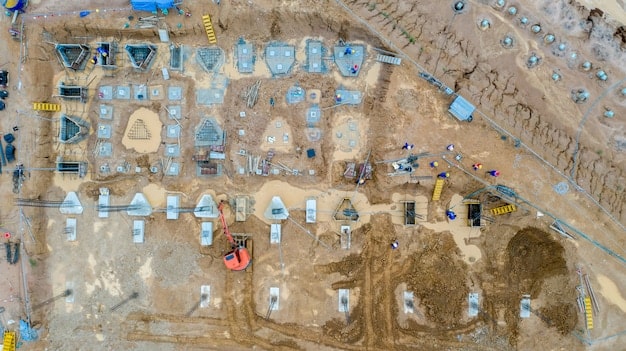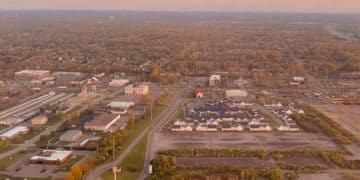US Skilled Trades Shortage: Impact on Construction and Infrastructure

Anúncios
The nationwide shortage of skilled trades workers in the US is critically impacting the construction and infrastructure sectors, threatening project timelines, escalating costs, and hindering economic development, requiring immediate, multifaceted solutions.
Anúncios
The United States is grappling with a quiet but pervasive crisis: a deepening nationwide shortage of skilled trades workers. This evolving narrative isn’t just a challenge; it’s a foundational issue reshaping the landscape of development and maintenance across the nation, particularly within the construction and vital infrastructure sectors. Understanding the scope and implications of this deficit is crucial for anyone invested in the future of American building and economic stability.
The Looming Crisis: Understanding the Skilled Trades Gap
The scarcity of skilled trades professionals has become a critical bottleneck for industries reliant on hands-on expertise. From electricians and plumbers to carpenters, welders, and HVAC technicians, the demand consistently outstrips the supply. This isn’t a new phenomenon, but rather an acceleration of trends observed over the past decade, exacerbated by an aging workforce, changing educational priorities, and a societal shift away from vocational training. The implications are far-reaching, directly impacting project timelines, quality, and ultimately, national productivity.
Anúncios
For years, there has been a significant push towards four-year university degrees, often sidelining vocational education and the lucrative, stable careers available in the trades. This cultural bias, coupled with a lack of awareness about modern trade professions, has created a pipeline problem. The average age of skilled trades workers continues to rise, meaning a large segment of the workforce is nearing retirement, with insufficient young talent entering to fill these crucial roles. This demographic imbalance is a core contributor to the crisis.
Root Causes of the Shortage
Several intertwined factors contribute to the skilled trades deficit. Understanding these origins is the first step toward devising effective solutions.
- Aging Workforce: A substantial portion of current skilled trades workers are nearing retirement, creating a knowledge and labor vacuum as they exit the workforce.
- Perception of Vocational Training: Vocational schools and apprenticeships have often been perceived as less prestigious alternatives to four-year college degrees, leading to fewer young people pursuing these paths.
- Lack of Exposure and Awareness: Many K-12 educational systems have reduced or eliminated shop classes and vocational programs, limiting early exposure to the trades as viable career options.
- Economic Boom and Increased Demand: Periods of strong economic growth and large-scale infrastructure investment naturally increase the demand for skilled labor, further exposing existing shortages.
The perception issue is particularly challenging. Often, the skilled trades are mistakenly associated with dirty, low-tech jobs, when in reality, many modern trade professions involve sophisticated technology, advanced problem-solving, and offer competitive wages and benefits without the burden of significant student loan debt. Changing this narrative requires a concerted effort from all stakeholders, from educators to industry leaders and government bodies. The longer this perception persists, the harder it will be to attract the next generation of talent.
The lack of early exposure in schools means many students aren’t even aware these career paths exist, let alone the high earning potential and job security they offer. Without hands-on experience or even a basic understanding of what a welder or an electrician actually does, students are naturally less inclined to explore these fields. This disengagement at a formative age creates a systemic barrier to entry.
Direct Impact on Construction Projects
The most immediate and visible consequence of the skilled trades shortage is its profound effect on the construction industry. From residential housing developments to sprawling commercial complexes and critical public works, projects across the nation are feeling the strain. This shortage isn’t just an inconvenience; it translates directly into delays, cost overruns, and sometimes, the outright abandonment of projects essential for community growth and economic vitality.
Construction companies are reporting significant difficulties in finding qualified workers, leading to intense competition for available talent and driving up labor costs. This increased cost trickles down, impacting project budgets and ultimately, the consumer. A residential home, for instance, may cost more due to the scarcity of skilled framers or roofers, and take longer to build. For larger commercial projects, these delays can result in missed revenue targets for businesses and extended timelines for public services.
Project Delays and Cost Escalations
The domino effect of labor scarcity begins with project delays. Without enough electricians, plumbing installations fall behind schedule. Without skilled welders, structural elements can’t be completed. These delays accumulate, pushing back entire project completion dates, which can trigger penalty clauses, increase financing costs, and tie up capital for extended periods.
Beyond delays, the shortage inflates costs in several ways:
- Higher Wages and Benefits: Companies must offer more competitive compensation packages to attract and retain the limited skilled talent pool, directly increasing labor expenditures.
- Overtime Pay: To keep projects moving, existing workers often log extensive overtime hours, leading to higher labor costs and potential burnout.
- Reduced Productivity: Fewer experienced workers can lead to a dip in overall project efficiency and quality, sometimes requiring rework, which adds to costs.
- Subcontractor Issues: Prime contractors struggle to find available and affordable subcontractors for specialized trades, further contributing to delays and budget overruns.
Moreover, the quality of work can be compromised if less experienced workers are rushed into roles for which they are not fully prepared, or if companies are forced to accept lower-quality work due to lack of options. This can lead to long-term maintenance issues and safety concerns, adding another layer of cost and risk. The financial implications are not trivial, impacting profitability for companies and increasing the burden on taxpayers for public projects.
The current market dynamic forces many construction firms to be highly selective about which projects they can realistically undertake. Some may even decline bids if they anticipate an inability to staff the project effectively, leading to a bottleneck in development and growth across various sectors. This strategic restraint, while financially prudent for individual businesses, collectively hampers the nation’s capacity for progress.
Infrastructure Projects at Risk: A National Concern
Beyond general construction, the shortage poses an existential threat to critical infrastructure projects that are the backbone of the US economy and public safety. From upgrading aging bridges and roads to expanding broadband networks and modernizing energy grids, these ambitious and necessary undertakings require a massive, sustained influx of skilled labor. Without it, the nation risks falling behind in modernizing its foundational systems, leading to economic stagnation and potential safety hazards.
The bipartisan Infrastructure Investment and Jobs Act (IIJA), signed into law in 2021, allocated billions of dollars to overhaul America’s infrastructure. However, the efficacy of this historic investment hinges critically on the availability of a skilled workforce to execute these projects. If there aren’t enough trained professionals to build new highways, repair water pipes, or install renewable energy systems, these funds cannot be fully utilized, and the intended benefits will remain unrealized.
Challenges to Infrastructure Modernization
The challenges for infrastructure development are multifaceted, extending beyond just the direct labor shortage. The specialized nature of many infrastructure projects, from complex civil engineering to advanced pipeline installation, demands highly specific skills that are even scarcer.
Consider the energy sector, which is undergoing a massive transition towards renewable sources. Installing solar farms, constructing wind turbines, and building new transmission lines all require highly specialized electricians, ironworkers, and heavy equipment operators. The current workforce often lacks the specific training needed for these evolving technologies.
The impacts on national infrastructure include:
- Delayed Essential Repairs: Critical repairs and maintenance on existing infrastructure, such as aging water systems or deteriorating bridges, may be postponed, increasing the risk of failures.
- Hindered New Development: Plans for new roads, airports, and public transit systems face significant hurdles, slowing down connectivity and economic growth.
- Increased Project Costs: As with general construction, the scarcity of labor drives up costs for public infrastructure projects, potentially straining taxpayer budgets further.
- National Security Implications: Delays in modernizing critical infrastructure, including cybersecurity and energy grid resilience, could have national security ramifications.
The competitive bidding process for these large contracts also suffers. When fewer qualified firms can bid due to labor constraints, the competitive market shrinks, potentially leading to higher bids overall. This scenario directly impacts public funds and reduces the efficiency with which infrastructure improvements can be made. The current environment may also push for innovative technologies and automation in infrastructure development, but these too require a skilled workforce to design, install, and maintain them.

Addressing the Shortage: Education and Recruitment Strategies
Tackling the skilled trades shortage requires a multi-pronged approach, focusing on revitalizing vocational education, improving recruitment efforts, and shifting societal perceptions. It’s not a quick fix, but a long-term investment in the nation’s future workforce. The solutions must originate from various sectors: government, educational institutions, industry, and individual communities.
One of the most critical areas for intervention is education. Reintegrating robust vocational and technical training into high school curricula is paramount. This includes funding for modern equipment, qualified instructors, and partnerships with local businesses for hands-on experience and apprenticeship opportunities. Technical colleges and community colleges also play a vital role, often serving as primary pathways for individuals to enter the trades. These institutions need continued investment and adaptation to ensure their programs meet current industry demands.
Key Strategies for Workforce Development
A comprehensive strategy involves reaching out to diverse demographics and creating clear, accessible pathways into skilled trades.
- Strengthening Vocational Education: Increased funding and emphasis on vocational training programs in high schools and community colleges. This means more modern equipment, better-qualified instructors, and relevant curricula.
- Promoting Apprenticeships: Expanding and promoting registered apprenticeship programs, which offer paid on-the-job training combined with theoretical instruction. These programs are highly effective in producing skilled workers.
- Changing Perceptions: Launching public awareness campaigns to highlight the value, earning potential, and career stability of skilled trade professions. Showcasing success stories and modern work environments can help.
- Targeted Recruitment: Actively recruiting diverse populations, including women, veterans, and minorities, who are often underrepresented in the trades.
- Incentives for New Entrants: Exploring tuition assistance, grants, or tax breaks for individuals pursuing skilled trades education or apprenticeships.
Industry partnerships are also crucial. Companies can collaborate with educational institutions to design curricula that directly address their needs and offer internships or apprenticeships. This creates a direct pipeline from training to employment, benefiting both the student and the employer. Furthermore, mentorship programs can help retain new entrants by providing support and guidance as they navigate their careers.
The marketing of skilled trades careers needs a serious overhaul. Instead of outdated imagery, campaigns should showcase the high-tech, innovative, and often well-compensated reality of these professions. Highlight the independence, problem-solving, and tangible results associated with working in the trades. Changing the narrative away from “blue-collar” versus “white-collar” and towards “skills-based” careers that contribute directly to society is essential.
Government Initiatives and Policy Responses
Recognizing the gravity of the skilled trades shortage, various levels of government are beginning to implement policies and initiatives aimed at mitigating the crisis. These efforts range from federal funding for vocational programs to state-level incentives and partnerships designed to bolster the skilled labor pool. However, fragmentation and insufficient scale remain challenges, suggesting a need for more unified and aggressive action.
At the federal level, policymakers are exploring ways to leverage existing programs and create new ones that support vocational training and apprenticeships. Specific grants for states and educational institutions are being considered or expanded to modernize facilities and curricula. The intent is to make skilled trades a more attractive and accessible option for young Americans, moving away from the sole emphasis on four-year university degrees.
Policy Frameworks and Funding
Government intervention is critical for providing the necessary funding, regulatory support, and strategic direction to address the shortage effectively.
- Federal Funding for CTE: Increased appropriations for Career and Technical Education (CTE) programs, allowing schools to purchase new equipment, expand course offerings, and hire more instructors.
- Apprenticeship Expansion: Initiatives to streamline the registration process for new apprenticeship programs and provide financial incentives to businesses that offer them.
- Tax Credits and Incentives: Exploring tax credits for businesses that invest in workforce development, or for individuals pursuing specific trade certifications.
- Skilled Trades Modernization Acts: Legislative efforts to modernize perception and education around skilled trades, potentially through national campaigns and curriculum standards.
- Immigration Reform: Consideration of immigration policies that facilitate the entry and integration of skilled trades professionals from other countries to fill immediate gaps, while simultaneously bolstering domestic training.
State governments are also stepping up, with some states offering scholarships for students enrolling in vocational programs or providing direct grants to employers who establish paid internship or apprenticeship programs. Local municipalities are sometimes partnering with construction companies and trade unions to create localized training centers that cater to specific regional needs, ensuring that the skills taught are directly applicable to available jobs in the area.
Another critical component is the collection and analysis of data regarding regional and national skill gaps. Governments can play a key role in identifying where the shortages are most acute and what specific skills are most in demand. This data can then inform educational institutions and training programs, ensuring that resources are allocated effectively and that training aligns with industry needs.
The Role of Technology and Innovation
While the focus remains on human capital, technology and innovation are beginning to play an increasingly significant role in alleviating some of the pressures from the skilled trades shortage. Robotics, automation, advanced software, and new construction methods are not just futuristic concepts; they are becoming practical tools that augment the existing workforce, improve efficiency, and potentially make trade professions more appealing to a tech-savvy generation.
However, it’s important to clarify that technology is not a panacea that will entirely replace the need for skilled human hands. Rather, it offers solutions to improve productivity, reduce labor intensity, and make jobs safer and more precise. For example, robotic bricklayers can speed up wall construction, but they still require skilled operators for setup, programming, and quality control. Prefabrication and modular construction methods can move some labor from the unpredictable job site to controlled factory environments, but this shifts, not eliminates, the need for skilled factory workers.
Augmenting the Trades, Not Replacing Them
Technological advancements that can help address the labor shortage include:
- Automation and Robotics: Implementing automated equipment for repetitive or dangerous tasks, such as robotic welding or drone-based inspections, freeing human workers for more complex roles.
- Advanced Software and BIM: Utilizing Building Information Modeling (BIM) and other sophisticated software for design, planning, and project management, improving efficiency and reducing errors, thus requiring fewer personnel for rework.
- Virtual and Augmented Reality (VR/AR): Using VR/AR for training purposes, allowing students and apprentices to practice complex tasks in a safe, simulated environment, accelerating skill acquisition.
- Prefabrication and Modular Construction: Shifting construction tasks off-site into controlled factory settings, where work can be standardized and executed with greater efficiency, reducing on-site labor needs.
- Wearable Technology and AI: Equipping workers with wearable tech for enhanced safety, communication, and data collection, and using AI for predictive maintenance or scheduling optimization.
The integration of these technologies requires a new set of skills, often blending traditional trade knowledge with digital literacy. This means that future skilled trades workers will need to be proficient not only in their craft but also in understanding and interacting with advanced machinery and software. This evolution could potentially attract a new generation of workers who are drawn to technology and innovation, viewing the trades as modern and forward-thinking careers.
However, the adoption of new technologies also presents challenges, including the upfront investment costs for equipment and the need to retrain the existing workforce. Companies need to invest in continuous learning programs to ensure their workers can effectively utilize these new tools. The ultimate goal is to create a symbiotic relationship where technology empowers skilled workers to be more productive and efficient, rather than displacing them.
Future Outlook and Long-Term Solutions
The ongoing nationwide shortage of skilled trades workers demands a comprehensive, sustained, and adaptive approach for the long term. While immediate interventions can help alleviate some pressure, a true resolution requires fundamental shifts in societal attitudes, educational systems, and industry practices. The future health of the US economy, its infrastructure, and its capacity for innovation are inextricably linked to the availability and proficiency of its skilled workforce.
One of the most critical long-term solutions involves a systemic change in how vocational education is perceived and funded from elementary school through post-secondary training. This means reintroducing hands-on learning, promoting apprenticeship models as viable and respected pathways, and ensuring that trade schools are equipped with cutting-edge technology and experienced instructors. It’s about creating a culture where a career in the trades is recognized for its immense value, both personally and societally.
Building a Robust Skilled Workforce for Tomorrow
For a sustainable future, several long-term strategies must be vigorously pursued:
- Early Exposure and Mentorship: Implementing K-12 programs that introduce students to skilled trades through engaging, practical experiences, coupled with mentorship opportunities from current professionals.
- Lifelong Learning and Upskilling: Establishing robust programs for continuous education and upskilling for existing workers, ensuring they remain proficient with evolving technologies and industry standards.
- Industry-Led Training Consortia: Encouraging the formation of industry consortia that pool resources to develop and deliver highly specialized training programs, responding directly to industry needs.
- Data-Driven Workforce Planning: Utilizing sophisticated data analytics to forecast future skill demands, allowing educational institutions and governments to proactively align training with job market requirements.
- Advocacy for Policy Change: Ongoing advocacy for federal and state policies that prioritize vocational education, fund training initiatives, and provide economic incentives for both students and employers in the trades.
Furthermore, fostering a diverse and inclusive workforce is not just a moral imperative but an economic necessity. Actively recruiting and supporting women, minorities, and veterans in entering the skilled trades can significantly expand the talent pool. This requires addressing cultural barriers, providing supportive work environments, and highlighting role models from these communities.
Finally, consistent public awareness campaigns are essential to dismantle outdated stereotypes about trade jobs. Showcasing the innovation, intellectual challenge, and economic stability of these careers can inspire a new generation to consider paths beyond the traditional four-year college degree. The skilled trades are not just jobs; they are essential professions that build and maintain the world around us, and their importance must be universally recognized.
| Key Point | Brief Description |
|---|---|
| 🛠️ Workforce Gap | An aging workforce and declining interest in vocational training have created a severe shortage of skilled trades workers like electricians, plumbers, and carpenters. |
| 🏗️ Project Impact | This shortage causes significant project delays and escalating costs in both general construction and critical infrastructure development across the nation. |
| EDU Solutions | Revitalizing vocational education, promoting apprenticeships, and shifting public perception are crucial strategies to attract and train new talent. |
| 💡 Tech Integration | Technology and automation are augmenting, not replacing, skilled workers, improving efficiency and making trades more appealing to tech-savvy individuals. |
Frequently Asked Questions About the Skilled Trades Shortage
A skilled trades worker is a person who has specialized training, expertise, and often certification in a particular craft or technical field. Examples include electricians, plumbers, carpenters, welders, HVAC technicians, masons, and heavy equipment operators. These roles typically involve hands-on work and require formal education from vocational schools, community colleges, or extensive apprenticeship programs
The shortage stems from several factors, including an aging workforce nearing retirement, a societal shift towards four-year university degrees deemphasizing vocational schools, a lack of early exposure to trades in high schools, and inadequate funding for modern vocational training programs. Additionally, during economic downturns, many skilled workers left the industry and did not return.
The shortage directly leads to project delays, as there aren’t enough qualified professionals to complete tasks on time. It also drives up labor costs due to competition for scarce talent, which can lead to higher project bids and overall cost overruns. Quality control can also suffer if less experienced workers are assigned complex tasks without adequate supervision, potentially affecting safety and longevity.
Apprenticeships are a cornerstone solution. They provide paid, on-the-job training combined with classroom instruction, allowing individuals to earn a living while learning a trade. This model effectively transfers knowledge from experienced workers to new entrants, creating a direct pipeline of skilled labor. Expanding and promoting registered apprenticeship programs is crucial for building the future workforce.
Attracting more individuals requires multiple strategies: investing in and promoting vocational education from K-12 onward, running public awareness campaigns that highlight the high earning potential and job security in trades, offering incentives like scholarships or tax credits, and encouraging diversity and inclusion within the trades. Showcasing the modern, tech-driven aspects of these careers is also vital to appeal to younger generations.
Conclusion
The ongoing nationwide shortage of skilled trades workers is more than a developing story; it is a critical challenge with tangible impacts on the economic health and infrastructural integrity of the United States. While the complexities are undeniable, the path forward is clear: a concerted, multi-stakeholder effort focusing on revitalizing vocational education, promoting apprenticeships, leveraging technology, and actively changing societal perceptions about the value and viability of skilled trades careers. By prioritizing these crucial professions, the nation can ensure a robust workforce capable of building, maintaining, and innovating for generations to come, safeguarding its future prosperity and resilience.





